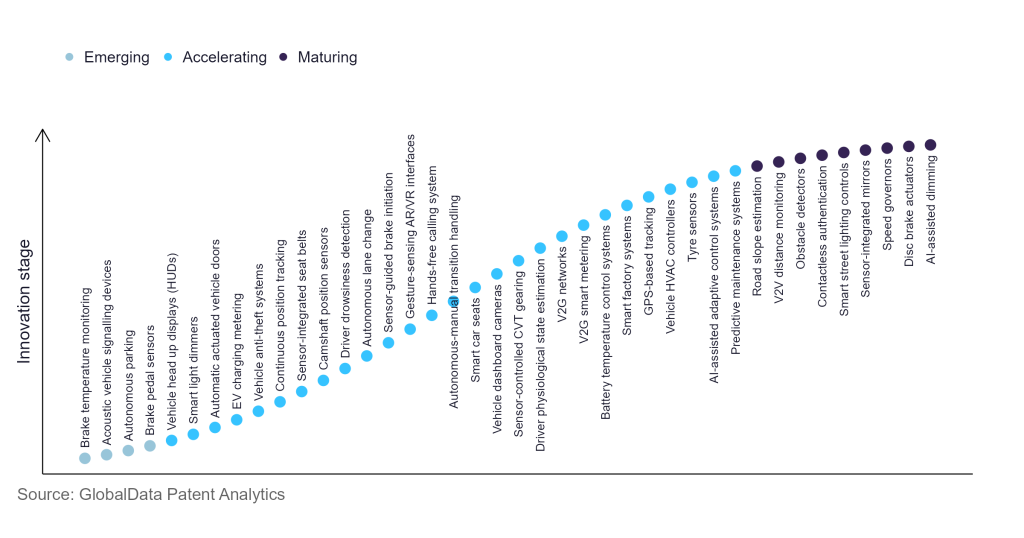The automotive industry continues to be a hotbed of innovation, with activity driven by autonomous vehicles, automated connected vehicles, and enhanced safety concerns, and growing importance of technologies such as radar sensors, ultrasonic sensors and infrared sensors. In the last three years alone, there have been over 1.2 million patents filed and granted in the automotive industry, according to GlobalData’s report on Internet of Things in Automotive: Obstacle detectors. Buy the report here.
However, not all innovations are equal and nor do they follow a constant upward trend. Instead, their evolution takes the form of an S-shaped curve that reflects their typical lifecycle from early emergence to accelerating adoption, before finally stabilising and reaching maturity.
Identifying where a particular innovation is on this journey, especially those that are in the emerging and accelerating stages, is essential for understanding their current level of adoption and the likely future trajectory and impact they will have.
290+ innovations will shape the automotive industry
According to GlobalData’s Technology Foresights, which plots the S-curve for the automotive industry using innovation intensity models built on over 619,000 patents, there are 290+ innovation areas that will shape the future of the industry.
Within the emerging innovation stage, acoustic vehicle signalling devices, autonomous parking, and brake pedal sensors are disruptive technologies that are in the early stages of application and should be tracked closely. Vehicle head up displays (HUDs), smart light dimmers, and automatic actuated vehicle doors are some of the accelerating innovation areas, where adoption has been steadily increasing. Among maturing innovation areas are road slope estimation and V2V distance monitoring, which are now well established in the industry.
Innovation S-curve for IoT in the automotive industry

Obstacle detectors is a key innovation area in IoT
An obstacle detection system comprises ultrasonic sensors fitted on the front and/or rear bumpers. The sensors measure the distance between a car and nearby obstacles directly around the front or rear bumper. The driver is alerted by beeps or the dashboard display.
GlobalData’s analysis also uncovers the companies at the forefront of each innovation area and assesses the potential reach and impact of their patenting activity across different applications and geographies. According to GlobalData, there are 50+ companies, spanning technology vendors, established automotive companies, and up-and-coming start-ups engaged in the development and application of obstacle detectors.
Key players in obstacle detectors – a disruptive innovation in the automotive industry
‘Application diversity’ measures the number of different applications identified for each relevant patent and broadly splits companies into either ‘niche’ or ‘diversified’ innovators.
‘Geographic reach’ refers to the number of different countries each relevant patent is registered in and reflects the breadth of geographic application intended, ranging from ‘global’ to ‘local’.
Patent volumes related to obstacle detectors
Source: GlobalData Patent Analytics
Denso is a key player in the obstacle detectors innovation area. It has developed a new standard vision sensor that detects pedestrians, cyclists, road signs, driving lanes and other road users at night. Working in combination with a millimetre wave radar sensor, the sensor permits automobiles to automatically activate emergency braking when obstacles are recognised, helping decrease accidents and enhancing overall vehicle safety. Toyota, Intel, Hyundai, Robert Bosch Stiftung and Alphabet are some of the other key players.
To further understand how IoT is disrupting the automotive industry, access GlobalData’s latest thematic research report on Internet of Things (IoT) in Automotive.
Premium Insights
From

The gold standard of business intelligence.
Blending expert knowledge with cutting-edge technology, GlobalData’s unrivalled proprietary data will enable you to decode what’s happening in your market. You can make better informed decisions and gain a future-proof advantage over your competitors.





